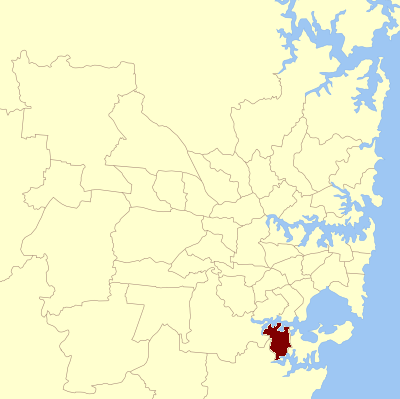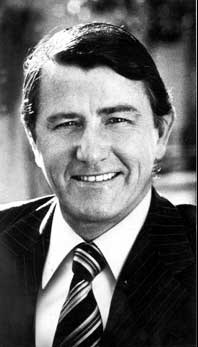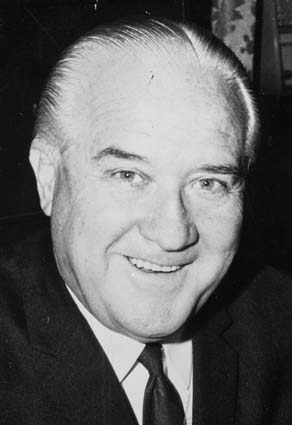|
2013 Miranda State By-election
A by-election for the New South Wales Legislative Assembly seat of Miranda occurred on 19 October 2013. The by-election was triggered by the resignation of Graham Annesley (), which was announced on 28 August 2013. Barry Collier () won the seat with a 55 percent two-party vote from a 26-point two-party swing, the largest swing in New South Wales history. Background The Liberal member for Miranda, Graham Annesley, resigned from the New South Wales Parliament and as Minister for Sport and Recreation on 28 August 2013 to take up the post of chief executive officer of the Gold Coast Titans rugby league team. Annesley in his resignation to Parliament said he never regarded himself as a politician and that there were many aspects of politics he did not care for and he has always felt more at home as a sports administrator. A central Sutherland Shire electorate, Miranda crosses the peninsula between the Georges River and Port Hacking. It includes the suburbs of Como, Bonnet Bay, ... [...More Info...] [...Related Items...] OR: [Wikipedia] [Google] [Baidu] |
Miranda NSW State Electoral District
Miranda may refer to: Law * ''Miranda v. Arizona'', an American legal case * ''Miranda'' warning, an American police warning given to suspects about their rights, before they are interrogated Places Australia * Miranda, New South Wales * Miranda railway station, New South Wales Portugal * Miranda do Corvo, a ''município'' in Coimbra District, Centro * Miranda do Douro (parish), a ''freguesia'' in Bragança District, Norte * Miranda do Douro, a ''município'' in Bragança District, Norte * Terra de Miranda, a plateau in Bragança District, Norte Spain * Miranda (Avilés), a parish of Avilés, Asturias * Belmonte de Miranda, Asturias * Miranda de Arga, Navarre * Miranda de Ebro, Castile and Leon * , in Los Rábanos, in the Province of Soria, Castile and Leon * Miranda del Castañar, in the Province of Salamanca, Castile and Leon United States * Miranda, California * Miranda, South Dakota Venezuela * Miranda (state) * Francisco de Miranda Municipality, Anzoátegui * Francisc ... [...More Info...] [...Related Items...] OR: [Wikipedia] [Google] [Baidu] |
Grays Point, New South Wales
Grays Point is a small affluent suburb in Southern Sydney, in the state of New South Wales, Australia 29 kilometres south of the Sydney central business district, in the local government area of the Sutherland Shire. Grays Point is a small suburb with extensive views of the Port Hacking estuary. Grays Point is adjacent to the Royal National Park and the suburbs of Gymea Bay and Kirrawee. There is only one road available for vehicular access however multiple walking and mountain bike tracks link it with locations such as Audley in the Royal National Park, Engadine and Heathcote. This, in turn, contributes to the exclusive atmosphere of the suburb. Grays Point house prices are higher than comparable real estate in the southern Sydney region. The median price for a three bedroohouse is $1.3m Properties in the area are tightly held and often remain within families for multiple generations. Houses are highly sought after, especially those with access to the surrounding ... [...More Info...] [...Related Items...] OR: [Wikipedia] [Google] [Baidu] |
Australian Broadcasting Corporation
The Australian Broadcasting Corporation (ABC) is the national broadcaster of Australia. It is principally funded by direct grants from the Australian Government and is administered by a government-appointed board. The ABC is a publicly-owned body that is politically independent and fully accountable, with its charter enshrined in legislation, the ''Australian Broadcasting Corporation Act 1983''. ABC Commercial, a profit-making division of the corporation, also helps to generate funding for content provision. The ABC was established as the Australian Broadcasting Commission on 1 July 1932 by an act of federal parliament. It effectively replaced the Australian Broadcasting Company, a private company established in 1924 to provide programming for A-class radio stations. The ABC was given statutory powers that reinforced its independence from the government and enhanced its news-gathering role. Modelled after the British Broadcasting Corporation (BBC), which is funded by a tel ... [...More Info...] [...Related Items...] OR: [Wikipedia] [Google] [Baidu] |
2003 New South Wales State Election
Elections to the 53rd Parliament of New South Wales were held on Saturday 22 March 2003. All seats in the Legislative Assembly and half the seats in the Legislative Council were up for election. The Labor Party led by Bob Carr won a third four-year term against the Liberal-National Coalition led by John Brogden. Future New South Wales premiers, Gladys Berejiklian and Kristina Keneally, entered parliament at this election. Background In the 18 months following the 1999 election politics was swamped by the Olympics. The only problem in this period was an administrative disaster in organising the ballot to purchase tickets. Games organisers were trying to hold back tickets originally promised at a lower price to the public in an attempt to deal with the financial viability of the Olympics. Chikarovski remained as Liberal leader after the 1999 election, partly because no-one wanted the job before the Olympics, but also because there was no clear alternative. A challenge fi ... [...More Info...] [...Related Items...] OR: [Wikipedia] [Google] [Baidu] |
1999 New South Wales State Election
Elections to the 52nd Parliament of New South Wales were held on Saturday, 27 March 1999. All seats in the Legislative Assembly and half the seats in the Legislative Council were up for election. The Labor Party, led by premier Bob Carr won a second term with a 7% swing against the Liberal Party and National Party, led by Kerry Chikarovski. The poll was the first to be held after two key changes to the electoral system. In 1997, the number of electoral districts was reduced from 99 to 93. In 1995, fixed four-year terms were introduced. Background Carr Government The Labor Party's victory at the 1995 election was built on a number of specific promises, backed by a well directed marginal seat campaign. On taking office, the Carr Government faced difficulties presiding over a public sector that had fundamentally changed during the seven years of the Greiner and Fahey Governments. The major dynamic of the Carr Government's first term was to be the clash between the old fashio ... [...More Info...] [...Related Items...] OR: [Wikipedia] [Google] [Baidu] |
Bob Carr
Robert John Carr (born 28 September 1947) is an Australian retired politician and journalist who served as the 39th Premier of New South Wales from 1995 to 2005, as the leader of the NSW Branch of the Australian Labor Party (ALP). He later entered federal politics as a New South Wales senator, and served as Minister for Foreign Affairs from 2012 to 2013. Following his departure from politics he served as the Director of the Australia-China Relations Institute (ACRI) from 2014 to 2019 at the University of Technology Sydney (UTS). Carr was born in Sydney and attended the University of New South Wales. Before entering politics he worked as a journalist. Carr entered the New South Wales Legislative Assembly in 1983, and the following year became a cabinet minister. He served under Neville Wran and Barrie Unsworth until the Labor government was defeated in a landslide at the 1988 state election. Carr subsequently replaced Unsworth as party leader, thus becoming leader of the op ... [...More Info...] [...Related Items...] OR: [Wikipedia] [Google] [Baidu] |
1981 New South Wales State Election
Elections were held in the state of New South Wales, Australia, on Saturday 19 September 1981. The result was a second "Wranslide": a landslide victory for the Labor Party under Neville Wran. Labor increased its already sizeable majority, winning what is still its biggest-ever share of seats in the New South Wales Legislative Assembly–69 out of 99 seats, 69.7 percent of the chamber. The Liberals suffered the double indignity of losing the seat contested by their leader Bruce McDonald to an independent, and of being reduced to the same number of seats in parliament as their ostensible junior coalition partner, the National Country Party. In fact it was the second election in a row in which the sitting Liberal leader had failed to win a seat; Peter Coleman had been rolled in his own seat in 1978. Both the Liberals and National Country Party finished with 14 seats. The election marked another milestone for electoral reform in New South Wales. The allocation of preferences b ... [...More Info...] [...Related Items...] OR: [Wikipedia] [Google] [Baidu] |
1978 New South Wales State Election
A general election was held in the state of New South Wales, Australia, on Saturday 7 October 1978. The result was a landslide victory for the Labor Party under Neville Wran, popularly known as the "Wranslide." It is notable for being so successful for the Labor Party that it tallied 57 percent of the primary vote, the largest primary vote for any party in over a century. Having gone into the election with a razor-thin majority of one seat, Labor scored a 13-seat swing, giving it a strong majority of 63 seats. Labor even managed to defeat the Leader of the Opposition, Peter Coleman, in his own electorate. The seats of many other prominent Shadow Ministers fell to Labor as well. Labor also won took many seats in areas long reckoned as Coalition heartland. Among them were four seats that Labor had never won before this election-- Willoughby (contested for the Liberal Party by Nick Greiner who later became Premier), Manly, Wakehurst and Cronulla. It also came within stri ... [...More Info...] [...Related Items...] OR: [Wikipedia] [Google] [Baidu] |
Neville Wran
Neville Kenneth Wran, (11 October 1926 – 20 April 2014) was an Australian politician who was the Premier of New South Wales from 1976 to 1986. He was the national president of the Australian Labor Party (ALP) from 1980 to 1986 and chairman of both the Lionel Murphy Foundation and the Commonwealth Scientific and Industrial Research Organisation (CSIRO) from 1986 to 1991. Early years Wran was born in the Sydney suburb of Paddington, the eighth and last child of Joseph Wran and his wife Lillian (née Langley). He was educated at Nicholson Street Public School, Balmain, Fort Street Boys High and the University of Sydney, where he was a member of the Liberal Club, and from which he gained a Bachelor of Laws in 1948. He was admitted as a solicitor in 1951, called to the Bar in 1957, and became a Queen's Counsel in 1968. His great-grandfather, the eminent High Victorian architectural sculptor, Thomas Vallance Wran (1832-1891), whose carvings can be seen on the Martin Place ... [...More Info...] [...Related Items...] OR: [Wikipedia] [Google] [Baidu] |
1971 New South Wales State Election
Elections for the New South Wales Legislative Assembly were held in the state of New South Wales, Australia, on Saturday 13 February 1971. The Liberal- Country Party coalition government led by Sir Robert Askin won a third term in office. The Labor Party opposition was led by Pat Hills. The Legislative Assembly had been enlarged by two members to 96 for the 1971 election. The seats of Sturt and Casino were established. Until 2019, this was the last time the Coalition won a third-term in New South Wales. Key dates Results Seats changing hands * In addition, Labor held the seat of Georges River The Georges River, also known as Tucoerah River, is an intermediate tide-dominated drowned valley estuary, located to the south and west of Sydney, New South Wales, Australia. The river travels for approximately in a north and then easterly ..., which it had won from the Liberals at the 1970 by-election. Post-election pendulum See also * Candidates ... [...More Info...] [...Related Items...] OR: [Wikipedia] [Google] [Baidu] |
Division Of Cook
The Division of Cook is an Australian electoral division in the State of New South Wales. History Cook was created in 1969, mostly out of the Liberal-leaning areas of neighbouring Hughes. It was thus a natural choice for that seat's one-term Liberal member, Don Dobie, to transfer after the creation of Cook erased his majority in Hughes. The division was named in honour of James Cook, who mapped the east coast of Australia in 1770. In 2006, the Australian Electoral Commission's Redistribution Committee for New South Wales proposed that the division be jointly named for Joseph Cook, the sixth Prime Minister of Australia from 1913 to 1914. However as of 2022 no such action has been taken, and therefore Joseph Cook remains the only eligible Prime Minister who does not have a federal electorate named after him. For most of the first quarter-century of its existence, Cook was a marginal to fairly safe Liberal seat; it has been in Liberal hands for all but two terms. The Liberal ... [...More Info...] [...Related Items...] OR: [Wikipedia] [Google] [Baidu] |





.jpg)
Neville_Wrans_childhood_home.jpg)

